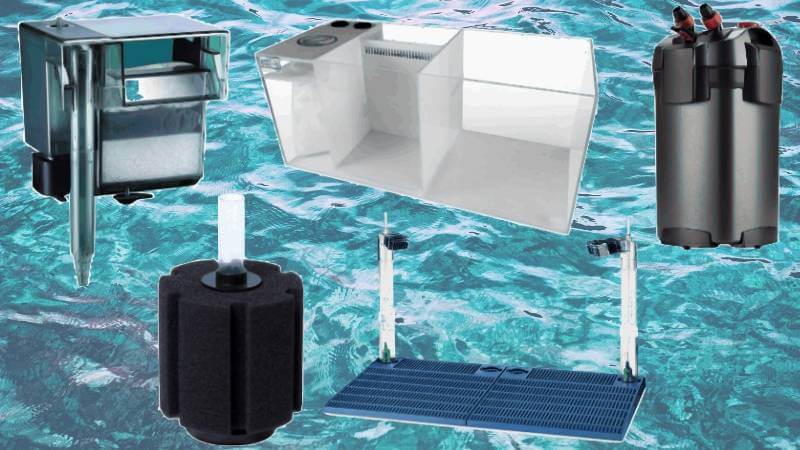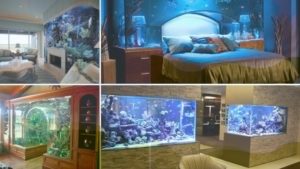Sharing is caring!
When it comes to filtering your aquarium, you have many options. But with so many options, which is the right one for you? Well, that depends on several factors, to include budget, aquarium size, type of substrate, and personal preference. The entire purpose of a filter is to keep the water clean, providing a healthy environment for your aquatic friends. This is done through mechanical, biological, and chemical filtration. You can read more about this here. All of the filter options are capable of doing all three with the exception of a sponge filter. We will go over them and discuss how each one functions so you can decide which is the best aquarium filter for you. The most common filter types are:
- HOB
- Canister
- Undergravel
- Sump
- Fluidized
- Trickle or Wet/Dry
- Sponge
- DIY
HOB filter
Hang on the Back filters, otherwise known as HOB filters are exactly what it sounds like. They hang on the back of your aquarium. An intake will rest inside your tank as water is pumped up into the filter flowing through various filter media. These make great starter filters because it’s usually what comes in the kits that the pet stores sell. Also, because of their ease of maintenance. Most HOB filters use cartridges that are considered consumable and can easily be replaced without any disruption to your aquarium. I don’t, however, recommend them to be replaced unless they are either falling apart or are beyond cleaning. As discussed earlier, your filter is where most of the beneficial bacteria live and throwing these away can crash your tank.
Try to use a HOB that has a multi-stage filtration system, meaning that it has room for multiple filter cartridges. This is so that you can replace one cartridge at a time if need be. Alternatively, some models have bio wheels that function independently from the filter cartridge allowing the filters to be replaced without losing all of the existing bacteria. If you have a tank large enough to require two HOB filters, you can simply replace one at a time. Some HOB filters have extra space inside that allows you to add in additional filter media as well.
Canister filter
A canister filter is an enclosed filtration system that is generally housed in a cabinet below your tank and is used on larger tanks. There will be an intake hose and an output hose that will go up and into your aquarium. A lot of hobbyists prefer this over a HOB because it’s hidden from view. Canister filters are on the pricier end but they function much more efficiently than other types. Another major benefit of this type of filter is the available space for filter media. When it comes to aquarium filtration, the more media, the better it will filter.
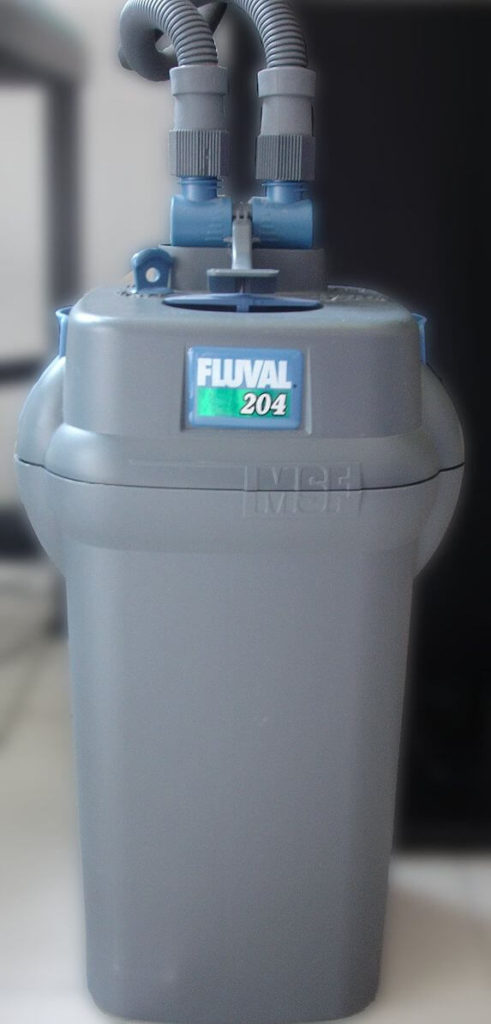
As water is pumped into the canister it forces the water, instead of the water simply flowing, to pass through the filter media before heading back to your tank. Since this system is under pressure you are able to push the water through a bunch of media without losing flow. These are very customizable allowing you to be in control of the types and sizes of the filters to fit your needs. They can be a bit of a pain to clean, but due to the way it works, they don’t need to be cleaned as often as other types. Either way, you’ll develop a system over time and realize it’s not that bad. I personally use canister filters on all of my larger tanks where I don’t have room for a sump.
Undergravel filter
With an undergravel filter what really changes is the location of the intake and what you use as a filter. As the name suggests, this filter lays at the bottom of your tank under your gravel and utilizes the gravel as the filter and has uptake tubes that return the water back to the top. Of course the finer the gravel the more waste is collected. Alternatively, a larger stone substrate or marble substrate won’t trap much waste. With that said though, this will not work with sand or anything small enough to fit through the slats of the filter.
Water flow is created, by the use of an airstone in an uptake tube, which will draw the water down through the gravel and up and out of the uptake. This can also be achieved by using a powerhead to pump the water. The waste that collects in the gravel is removed by vacuuming the substrate during your water change. I’ve also seen people place a filter sock over the output and sift the gravel around to loosen up the waste and have it flow through the filter slats.
Undergravel filters are usually pretty cheap and shouldn’t be used on any aquarium more than 20 gallons. I personally wouldn’t recommend its use on any size aquarium though. Yes, they do work but they can be pretty inefficient. Remember, although beneficial bacteria will live in your gravel, there is far less of a surface area for the bacteria to colonize on as opposed to using other filter media. Also, an undergravel filter offers no way to include chemical filtration.
Sump filtration
In my opinion sump filtration is by far the best style of filter out there. The problem is that it’s not always practical to use in all set-ups. A sump is basically another aquarium that’s hidden away which houses all of your filter media. The major benefit of a sump is that it’s completely customizable. Generally, a sump will be divided into different sections with each section performing a function. As water flows into your sump it will pass through your mechanical filtration and then flow into the next chamber, which is usually where your biological media would be kept. After passing through as many chambers as your sump has and all of the filtering, a pump will send the filtered water back into the tank.
A key difference with a sump over a canister filter is how the water is delivered into the filter. With a canister filter, the water is pumped out of your tank, but with a sump, your water freely flows through an over-flow. This is where drilling your tank would come in handy, although there are over-flows that don’t require drilling. As your filter pumps water back into your tank the water level will rise. When the water level reaches the top of the over-flow the water will drain down into your sump. The cycle repeats as long as the pump is running.
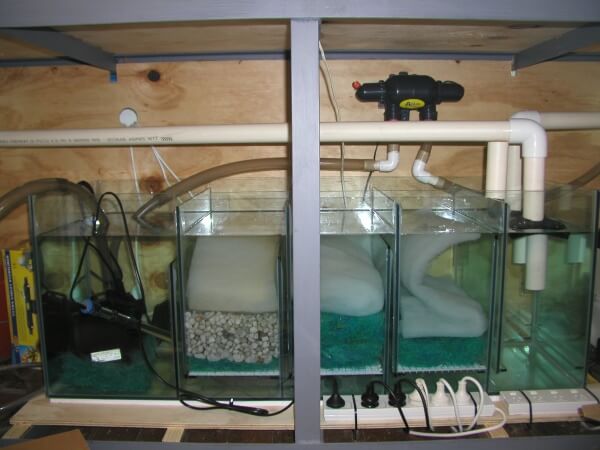
Your sump can also serve other functions aside from just filtration. First is water volume. Let’s say that you have a 90-gallon tank with a 30-gallon sump, you’ll have a total of 120 gallons of water volume. This creates a more stable environment and can even support more fish than a 90-gallon aquarium on its own could support. Secondly, you’ll never need to see those unsightly water heaters in your tank anymore. Just put them in your sump. Thirdly, since you are draining the water at the surface of your tank you’ll also be skimming the surface of the water. This is something that most filters can’t claim. The surface of your water can build up an oily residue, various micro-organisms, and any other floaters such as uneaten food that won’t sink. Having a clean surface will allow for better light penetration and better oxygen exchange. Any medicines or chemicals that need to be added to the tank can also be added into your sump instead of directly into your aquarium.
Fluidized filter
Simply put, a fluidized filter is where all of your filter media is suspended in water and stays in motion. As water is pumped from your tank it will flow through either sand or various other finer particle media. The sand will trap most of the debris before water flows back into the tank. Also since the media is suspended and under constant motion, there will be a good amount of oxygen present and will allow for good beneficial bacteria growth. These filters are pretty low maintenance but will require cleaning of the pump. Usually, this type of filter does not come as a complete kit and will require the extra purchase of a pump and hoses. You can increase the time between cleaning this filter by adding a prefilter, such as a filter sock, to the intake.
Special equipment really isn’t needed for this type of filter though since the technology is very simple. I’ve seen people build these out of 2-liter soda bottles. I think the best use of fluidized filtration is in a sump. As long as your sump chambers are set up in a way to allow water to flow up through the media and over to the pump chamber, this is an easy addition.
Trickle or Wet/Dry filter
A trickle filter, or wet/dry filter, is the opposite of a fluidized filter. In this setup, the media stays up and out of any flowing or standing water. Instead, water will collect above the filter media and rain, or trickle, down onto the media before being pumped back into the tank. In a trickle filter, your media is exposed to more oxygen than any other type of filter. Your beneficial bacteria will love this super oxygen-rich environment.
As with a fluidized filter, a wet/dry filter is an easy addition to your sump. You’ll want to add in some kind of mechanical filtration to this set-up though since its purpose is biological only. This can be accomplished with a sponge in your overflow box or by simply have a sponge in the trickle collection box. Or anywhere in your sump prior to being pumped back into your tank, although you generally want your mechanical filtration set before your biological.
Sponge filter
Sponge filtration is the simplest of all methods, and probably the cheapest too. They are a favorite in shrimp, quarantine, and fry tanks. A sponge filter stays inside of your aquarium and as water is drawn through the sponge it flows directly back into your tank. There are two methods to get water flowing through the sponge and that is either with an air stone or a powerhead. A powerhead will be attached to the end of the sponge filters lift tube and will pump the water through and out. This can also be accomplished by sticking an air stone in the lift tube. The rising air will draw the water through the sponge and out of the tube in the same way.
Many shrimp tanks use sponge filter because the shrimp love to feed off of whatever collects on the sponge. It will end up being a one-stop buffet for your invertebrate friends. They are also a great choice for quarantine tanks as they can be easily moved from an existing cycled tank. Breeding tanks incorporate a sponge filter since there is zero chance of this filter sucking up any of your baby fish, otherwise known as fry. Although a mechanical filter by design, a sponge filter is also very capable of maintaining a colony of beneficial bacteria.
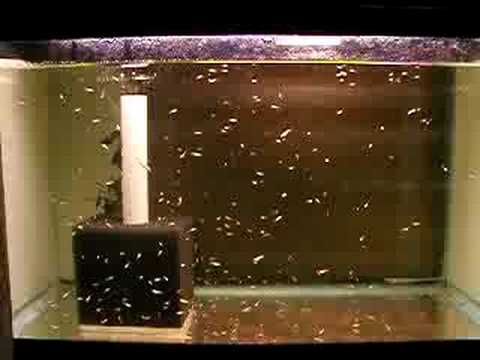
I personally always have a sponge filter running in my larger tanks just to keep them cycled with bacteria. In the event I ever need to quickly set up a tank for fish fry, quarantine, or a hospital tank, all I have to do is transfer the sponge filter and voila, a safe and cycled tank.
DIY and conclusion
I wanted to do a quick section on Do-It-Yourself since filtration is arguably the best and easiest place to, well, do things yourself. When it comes to filtering your aquarium water it truly doesn’t matter how or in what manner you accomplish this. As long as solid waste is being removed from the water and you have a place for the good bacteria to grow, you’re done. All that technical stuff is just extra. A sponge filter, as an example, can be added to the intake of any of these systems. Output nozzles can be modified to control your flow and to direct water wherever you want to either avoid or create currents. You can even replace these nozzles with spray bars.
Whether you build a fluidized filter with soda bottles and pool filter sand, or you put a trickle filter in-line with a fluidized filter which drains into your sump where you have a sponge filter running, the options are endless. That last example may be a bit of overkill, just FYI. Although, if you wanted to keep a sponge filter running in your sump in order to keep it seeded with bacteria, that makes sense. Especially if you want the benefits of it but don’t want to have to see it in your tank. Adding a sweet potato to your tank will help with the absorption of nitrates. Dream a little.
Sharing is caring!

